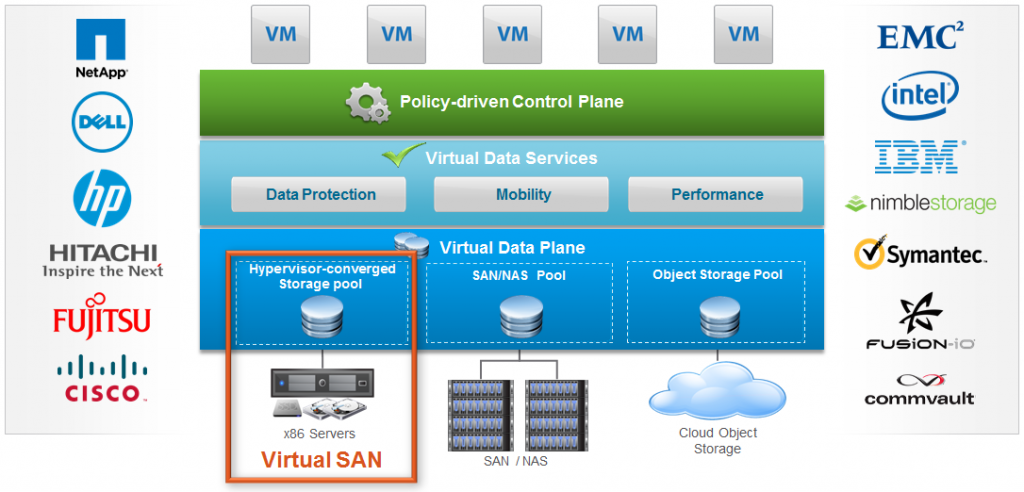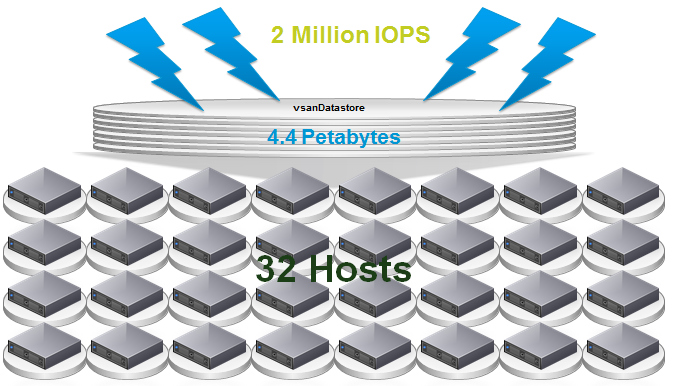This post is also available in: Italian
Reading Time: 4 minutesAfter the VMware NOW: Virtual SAN Special Online Event of past week (on Thursday, March 6, 2014), now VMware announce the GA Virtual SAN 5.5, a Software-Defined Storage with the declared objective to bring the efficient operational model of virtualization to the storage world.
This product was widely announced in previous VMworld and arrived after a long beta program with and unprecedented customer interest and validation: 12,000+ Virtual SAN Beta Participants represent an interesting number (also considering some prizes and contents during the beta period).
But the first message that come from the different announces is that this products will not override or suppress the storage ecosystem: will be just another option in the possible storage at the virtual data plane (note also the interesting Object Storage pool, that probably will mean something interesting in the next vSphere version):
It’s something revolution, evolution or it’s simple reinventing the wheel? Let’s analyze the diffent pillars of this product:
- Runs on any standard x86 server: nothing really new, most storage already runs on commodity hardware, but here it’s interesting that you can choose your system (according with the HCL)
- Scale out and scale in: interesting that could work in both directions, but not unique and for sure not new
- Built-in resiliency: at least is the minimum feature of an enterprise storage
- Policy-based management framework: basically each Software Defined Storage (SDS) could implement something similar at the control plane
- High performance hybrid flash architecture: lot of storage are using an hybrid approach (but of course not all approaches are the same)
- Embedded in vSphere kernel: this is really unique and rappresent a revolution: no more VM to implement the storage or no more storage appliance… a really convergent solution at the virtualization layer
So this product has some interesting features, some unique aspects, but mainly has a deep integration with VMware stack and compatibile with their technologies and products (and it’s really simple to activate, like enable the HA in a cluster). Will replace and suppress the storage ecosystem? It’s not his scope, but could change a lot the rules and move more to the SDS, scale-out and converged architecture.
We should also expect some systems realized by server vendor preconfigured for VSAN (basically systems with lot of disks) and this could be a great opportunity for vendors that maybe don’t have a storage solution, or have weak solutions.
And maximum numbers sounds really interesting (of course because you can reach those numbers, it does not really mean that you have to):
- Maximum number of node: 32 (that actually is the maximum number of hosts in a vSphere cluster)
- Maximum number of VMs: 3,200 (big number, but not necessary so big, in you consider, for example a VDI environment)
- Maximum performance: 2M IOPS (only read operations)
- Maximum capacity: 4.4 PetaByte
Scaling of this solution seems to be almost linear with this simple logic:
- Per magnetic disks – for capacity
- Per flash based device – for performance
- Per disk group – for performance and capacity
- Per node – for compute capacity
Will be a solution for all? Actually not: the old VMware VSA will not disappear and will be useful for SMB (covering 2 or 3 nodes). The new VSAN will need at least 3 nodes (with vSphere 5.5 U1 or later) and considering the price (price is per CPU, like vSphere ESXi) will be positioned in the medium-large market share. But there is also a proposed license for VDI with a cost per user that could become quite interesting. And of course there are some promo and discount in this initial phase.
For more information see also:




